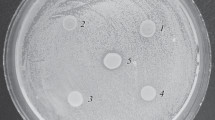Abstract
Broad-host-range plasmids, belonging to IncP (RP4 and pUPI102) and IncC (R57.b), were studied for intrageneric and intergeneric gene transfer in three different soil microcosms. RP4 was transferred intragenerically in clay loam, sandy loam, and sandy microcosms at frequencies of 0.71×10−2, 0.83×10−2, and 0.41×10−2 respectively, optimally at 37°C and at 100% vol/wt moisture content. Under similar conditions, R57.b was also transferred at frequencies of 0.38×10−2, 0.58×10−2, and 0.80×10−5 respectively at 30°C. Both RP4 and R57.b were transferred at low frequency at 20°C. Kinetics of plasmid transfer revealed that 48 h was the optimum time for intrageneric conjugal gene transfer. Gene transfer frequency was tenfold higher in all nutrient-amended soil microcosms than in the absence of nutrient amendment. RP4 was transferred to an indigenous soil bacteriumBeijerinckia indica in a nonsterile soil microcosm and to other indigenous soil bacteria, viz.Xanthomonas campestris, Azotobacter chroococcum, Acinetobacter calcoaceticus, Achromobacter agili, andRhizobium meliloti in sterile soil microcosms. pUPI102 was transferred fromA. calcoaceticus BD413 toEscherichia coli K12 J53 at a frequency of 0.75×10−6 and 1.1×10−6 in clay loam and sandy loam microcosms respectively. However, no gene transfer was observed in any soil microcosm when strains ofA. calcoaceticus BD413 (pUPI102) andE. coli K12 J53.2 (RP4) were used for conjugal mating. Plasmid RP4 was found to be 100% stable in all the above microorganisms.
Similar content being viewed by others
Literature Cited
Bachmann BJ (1972) Pedigrees of some mutant strains ofE. coli K12. Bacterial Rev 36:525–527
Berg G, Trevors JT (1990) Bacterial conjugation betweenE. coli andPseudomonas spp. donor and recipients cells in soil. J Ind Microbiol 5:79–84
Chopade BA (1986) Genetics of antibiotic resistance inAcinetobacter calcoaceticus. Ph.D. Thesis, University of Nottingham, England
Chopade BA, Wise PJ, Towner KJ (1985) Plasmid transfer and behaviour inAcinetobacter calcoaceticus EBF 65/65. J Gen Microbiol 131:2805–2811
Chopade BA, Patwardhan RB, Dhakephalkar PK (1993)Acinetobacter infections in India: genetic and molecular biological studies and some approaches to the problem. In: Proceedings of tropical diseases: molecular biology and control strategies. Lucknow: Central Drug Research Institute, CSIR publications, New Delhi, in press
Datta N, Hedges RW (1972) R factors identified in Paris, some conferring gentamycin resistance, constitute a new compatibility group. Ann Microbiol (Paris) 123:849–859
Datta N, Hedges RW, Shaw EJ, Sykes RB, Richmond MH (1971) Properties of R factors fromPseudomonas aeruginosa. J Bacteriol 108:1244–1249
Deshpande LM, Kapadnis BP, Chopade BA (1993) Metal resistance inAcinetobacter and its relation to β-lactamase production. BioMetals 6:55–59
Dhakephalkar PK, Murthi S, Seshadri PG, Puntambekar M, Chopade BA (1992) Genetic studies on pUPI102, a plasmid encoding resistance to tetracycline, gentamycin, neomycin and mercury inA. juni ACN4 In: Proceedings of DAE symposium on molecular biology of microorganisms. Bombay: Dept. of Atomic Energy, Govt. of India, pp 72–77
Juni E (1972) Interspecies transformation ofAcinetobacter: genetic evidence for a ubiquitous genus. J Bacteriol 112:917–931
Kanwar JS (1976) Soil fertility theory and practice. New Delhi: Indian Council of Agricultural Research [ICAR]
Karasovsky VN, Stotzky G (1987) Conjugation and genetic recombination inE. coli in sterile and non sterile soil. Soil Biol Biochem. 19:631–638
Kinkle BK, Schmidt EL (1991) Transfer of pea symbiotic plasmid pJB5JI in non sterile soil. Appl Environ Microbiol 57:3264–3269
Narayana N, Shah C (1966) Physical properties of soils. Bombay: Manaktalas Publishers
Prosser JI, Reid N (1992) A mathematical model of gene transfer on surfaces. Abstracts of 6th International Symposium on Microbial Ecology, Barcelona, p 105
Ramos MI, Gonzalez JM (1991) Conjugation transfer of recombinant DNA in cultures and in soils. Appl Environ Microbiol 57:3020–3027
Schilf W, Klingmuller W (1983) Experiments withE. coli on the dispersal of plasmids in environmental samples. Recomb DNA Tech Bull 6:101–102
Scott EM, Van Elsas JD, Bazin MJ, Lynch JM (1992) A mathematical model of gene exchange in a soil environment. Abstracts of 6th International Symposium on Microbial Ecology, Barcelona, p 105
Silhavy TJ, Berman ML, Erquist LW (1984) In: Experiments with gene fusions. Cold Spring Harbor Laboratory, NY: Cold Spring Harbor Laboratory Press, pp 147–148
Smith MS, Thomas GW, White RE, Ritonga D (1985) Transport ofE. coli through intact and disturbed soil columns. J Environ Qual 14:87–91
Stotzky G, Babich H (1986) Survival of and genetic transfer by genetically engineered bacteria in natural environments. Adv Appl Microbiol 12:547–563
Stotzky G, Rem LT (1966) Influence of clay minerals on microorganisms. Can J Microbiol 12:547–633
Sun L, Bazin MJ, Lynch JM (1993) Plasmid dynamics in a model soil column. Mol Ecol 2:9–15
Taher Khalil A, Gealt MA (1987) Temperature, pH and cations affect the ability ofE. coli to mobilize plasmids in broth and synthetic waste water. Can J Microbiol 33:733–737
Trevors JT, Barkay T (1987) Gene transfer among bacteria in soil and acquatic environments. Can J Microbiol 33:191–196
Trevors JT, Berg G (1988) Conjugal RP4 transfer betweenPseudomonas in soil and recovery of RP4 plasmid DNA from soil. Syst Appl Microbiol 11:223–227
Trevors JT, Oddie KM (1986) R plasmid transfer in soil and water. Can J Microbiol 32:610–613
Van Elsas JD, Johana M (1987) Transfer of plasmid pFT30 between bacilli in soil as influenced by bacterial population dynamics and soil conditions. Soil Biol Biochem 19:639–647
Weinberg SR, Stotzky G (1972) Conjugation and genetic recombination ofE. coli in soil. Soil Biol Biochem 4:171–180
Author information
Authors and Affiliations
Rights and permissions
About this article
Cite this article
Naik, G.A., Bhat, L.N., Chopade, B.A. et al. Transfer of broad-host-range antibiotic resistance plasmids in soil microcosms. Current Microbiology 28, 209–215 (1994). https://doi.org/10.1007/BF01575963
Issue Date:
DOI: https://doi.org/10.1007/BF01575963




